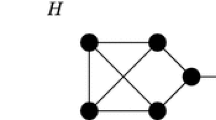Abstract
A composition of a positive integer in which a part of size n may be assigned one of n colors is called an n-color composition. Let a m denote the number of n-color compositions of the integer m. It is known that a m =F 2m for all m≥1, where F m denotes the Fibonacci number defined by F m =F m−1+F m−2 if m≥2, with F 0=0 and F 1=1. A statistic is studied on the set of n-color compositions of m, thus providing a polynomial generalization of the sequence F 2m . The statistic may be described, equivalently, in terms of statistics on linear tilings and lattice paths. The restriction to the set of n-color compositions having a prescribed number of parts is considered and an explicit formula for the distribution is derived. We also provide q-generalizations of relations between a m and the number of self-inverse n-compositions of 2m+1 or 2m. Finally, we consider a more general recurrence than that satisfied by the numbers a m and note some particular cases.
Similar content being viewed by others
References
Agarwal A K, n-Colour compositions, Indian J. Pure Appl. Math. 31(11) (2000) 1421– 1427
Agarwal A K, An analogue of Euler’s identity and new combinatorial properties of n-colour compositions, J. Comput. Appl. Math. 160 (2003) 9–15
Agarwal A K and Andrews G E, Rogers-Ramanujan identities for partitions with ‘N copies of N’, J. Combin. Theory Ser. A 45(1) (1987) 40–49
Benjamin A T and Quinn J J, Proofs that Really Count: The Art of Combinatorial Proof (2003) (Mathematical Association of America)
Bernstein M and Sloane N J A, Some canonical sequences of integers, Linear Algebra Appl. 226–228 (1995) 57–72
Eger S, Restricted weighted integer compositions and extended binomial coefficients, J. Integer Seq. 16 (2013) Art. 13.1.3
Flajolet P and Sedgewick R, Analytic Combinatorics (2009) (Cambridge University Press)
Graham R L, Knuth D E and Patashnik O, Concrete Mathematics: A Foundation for Computer Science (1994) (Addison-Wesley)
Guo Y-H, n-Colour even self-inverse compositions, Proc. Indian Acad. Sci. (Math. Sci.) 120(1) (2010) 27–33
Guo Y-H, Some n-color compositions, J. Integer Seq. 15 (2012) Art. 12.1.2
MacMahon P A, Combinatory Analysis, Vol. I, II (2001) (Chelsea Publishing American Mathematical Society)
Narang G and Agarwal A K, n-Colour self-inverse compositions, Proc. Indian Acad. Sci. (Math. Sci.) 116(3) (2006) 257–266
Narang G and Agarwal A K, Lattice paths and n-colour compositions, Discrete Math. 308 (2008) 1732–1740
Rivlin T, Chebyshev Polynomials, from Approximation Theory to Algebra and Number Theory (1990) (New York: John Wiley)
Sloane N J, The On-Line Encyclopedia of Integer Sequences, published electronically at http://oeis.org (2010)
Stanley R P, Enumerative Combinatorics, Vol. I (1997) (Cambridge University Press)
Author information
Authors and Affiliations
Corresponding author
Rights and permissions
About this article
Cite this article
MANSOUR, T., SHATTUCK, M. A statistic on n-color compositions and related sequences. Proc Math Sci 124, 127–140 (2014). https://doi.org/10.1007/s12044-014-0166-7
Received:
Revised:
Published:
Issue Date:
DOI: https://doi.org/10.1007/s12044-014-0166-7




